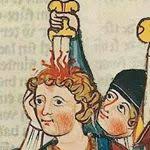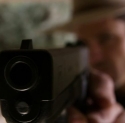HEY GAL posted:are we still talking about the early middle ages here A good point. After all, if we're really talking early middle ages, we're talking a pre/proto-chivalric conception of the warrior class for starters.
|
|
|
|
|

|
| # ? May 9, 2024 13:01 |
|
I'm late to the party, but a few brief points on the "warrior aristocracy" in the early Middle Ages, specifically the Carolingian period. First, it's often said that the primary social distinction in Carolingian (and in other early medieval societies) is not one between commoner and aristocrat, but between free and unfree people. As seen in Carolingian capitulary legislation, all free men technically had the obligation to serve in the army, suggesting that at least in theory all free people had recourse to a legitimate violence. That said, at least by the Carolingian period we can see the development of a "Christianized" military elite, very similar in character to knighthood, which is usually seen as a later medieval development. Dominic Barthélemy argues for this Carolingian Knighthood in his book The Serf, the Knight, the Historian, which is a good read for anyone interested in the modern scholarly debates over "feudalism." Now, did this "Carolingian knighthood" see itself as better because of breeding? Probably not.
|
|
|
|
deadking posted:I'm late to the party, but a few brief points on the "warrior aristocracy" in the early Middle Ages, specifically the Carolingian period. First, it's often said that the primary social distinction in Carolingian (and in other early medieval societies) is not one between commoner and aristocrat, but between free and unfree people. As seen in Carolingian capitulary legislation, all free men technically had the obligation to serve in the army, suggesting that at least in theory all free people had recourse to a legitimate violence. That said, at least by the Carolingian period we can see the development of a "Christianized" military elite, very similar in character to knighthood, which is usually seen as a later medieval development. Dominic Barthélemy argues for this Carolingian Knighthood in his book The Serf, the Knight, the Historian, which is a good read for anyone interested in the modern scholarly debates over "feudalism." I was thinking about this in relation to Anglo-Saxon/Danish England from that time period, and I'm struggling to figure out who makes up the "knighthood". If I remember correctly, the social ladder is essentially: King Ealdorman/Jarl Thegn Huscarl/household troops Fyrd/commoners Slaves Kings, commoners, and slaves are obvious, but I could see any or all of the other three being considered a Carolingian "knight" social class. The huscarls are professional warriors, but they aren't landed, and thegns, jarls, and ealdormen might not always be warriors but they definitely have the land.
|
|
|
|
I just saw this posted somewhere, maybe it's been posted in this thread before. Looks like almost all of it is extremely inaccurate, might give you all a good laugh.
|
|
|
|
It's, uh, pretty accurate, actually.
|
|
|
|
Check out the Military History Thread for relevant discussion, someone posted it there recently.
|
|
|
|
I'm not sure about the "arming swords hacking through mail" part.
|
|
|
|
goose fleet posted:I just saw this posted somewhere, maybe it's been posted in this thread before. Looks like almost all of it is extremely inaccurate, might give you all a good laugh. 17th century lancer armor, proofshot with a pistol bullet, ergo, bullets don't do poo poo. Also skipped the whole Mongol thing with the bowsies and arrowses. Too tired and lazy to argue. Archers too costly and useless. Gonna send them home, so that they can train more. Maybe shoot a butte or two.
|
|
|
|
JaucheCharly posted:17th century lancer armor, proofshot with a pistol bullet, ergo, bullets don't do poo poo. siivola, this thing is bad bad bad
|
|
|
|
It's got a mix of correct and incorrect information, though mostly the latter. also even when correct on the broad strokes it fucks up on the details. Honestly it is better to ignore it entirely than to spend the time sifting through what is right and what is wrong.deadking posted:I'm late to the party, but a few brief points on the "warrior aristocracy" in the early Middle Ages, specifically the Carolingian period. First, it's often said that the primary social distinction in Carolingian (and in other early medieval societies) is not one between commoner and aristocrat, but between free and unfree people. As seen in Carolingian capitulary legislation, all free men technically had the obligation to serve in the army, suggesting that at least in theory all free people had recourse to a legitimate violence. That said, at least by the Carolingian period we can see the development of a "Christianized" military elite, very similar in character to knighthood, which is usually seen as a later medieval development. Dominic Barthélemy argues for this Carolingian Knighthood in his book The Serf, the Knight, the Historian, which is a good read for anyone interested in the modern scholarly debates over "feudalism." Well in the 11th-early 12th century, knighthood was defined more by equipment and ability than by breeding. Wouldn't be surprised if such an attitude stretched to the 8th/9th century. Edit: Especially given that as I recall a lot of Carolingian land holdings were not hereditary. Is Barthélemy available in translation? Because it was a slog to get through the French last time I read him and I've got some new copies of the JMMH that I'd rather read first if he's only available in French. Rodrigo Diaz fucked around with this message at 22:17 on Jun 25, 2015 |
|
|
|
The highborn commanders were pretty incompetent, if you go by Tuchmann. She goes on about how knights disregarded complex tactics such as "scouting" and "having a sensible baggage train". Her conclusion was that a monopoly on warfare was bad because it was, well, a monopoly.
|
|
|
|
BravestOfTheLamps posted:"having a sensible baggage train"
|
|
|
|
BravestOfTheLamps posted:The highborn commanders were pretty incompetent, if you go by Tuchmann. She goes on about how knights disregarded complex tactics such as "scouting" and "having a sensible baggage train". Her conclusion was that a monopoly on warfare was bad because it was, well, a monopoly. A Distant Mirror is not regarded well as a scholastic work.
|
|
|
|
Rodrigo Diaz posted:It's got a mix of correct and incorrect information, though mostly the latter. also even when correct on the broad strokes it fucks up on the details. Honestly it is better to ignore it entirely than to spend the time sifting through what is right and what is wrong. Carolingian land holdings (at least those dispensed by the king) were in theory not hereditary, but there was a strong preference on the part of land holders to pass their offices to their children and the end result is a lot of de facto hereditary offices, if I'm remembering correctly (land tenure isn't really my forte). You're quite right about "knighthood" in the eleventh century being more about equipment and ability than an elite aristocratic group, though, to the point where I believe there's a tendency on the part of more recent historians to translate miles as armed horseman, or something similar, rather than knight. That said, Barthélemy is referring more to the later Christianized concept of knighthood having a strong Carolingian precedent. At least some of Barthélemy's work is translated into English. The book I mentioned in my previous post (The Serf, the Knight, and the Historian) is a translation of La mutation de l'an mil a-t-elle eu lieu?. He's quite an interesting, if rather polemical historian, especially in that book.
|
|
|
|
HEY GAL posted:siivola, this thing is bad bad bad 
|
|
|
|
Thanks for telling me. The example she used was (high ranked) knights bringing everything with them to war so they could live the high life on the march. Enough food for feasting, households worth of servants, hawks, etc. How accurate is that?
|
|
|
deadking posted:Carolingian land holdings (at least those dispensed by the king) were in theory not hereditary, but there was a strong preference on the part of land holders to pass their offices to their children and the end result is a lot of de facto hereditary offices, if I'm remembering correctly (land tenure isn't really my forte). The development of this in to a de jure situation as well as a de facto one is literally how some loose idea of what we call 'feudalism' but don't any more gets going in the Frankish kingdoms. What you're talking about is right, and more and more how things get as the Carolingian era presses on. As an aside, it certainly is the case that chivalric concepts have as one major origin the desire to emulate Frankish warriors like Roland, who was a margrave (Mark Graf/ Leader of a March), although a lot of that stuff is an ex post facto creation. Disinterested fucked around with this message at 23:41 on Jun 25, 2015 |
|
|
|
|
BravestOfTheLamps posted:Thanks for telling me. Seems like romanticism to me. I mean, they wouldn't be slumming it up like commoners, but these are guys who spent their entire life dedicated to martial prowess. They were not above doing some camping. I'm sure wealthier knights brought a few servants, and maybe even hawks/dogs/extra food, but they were definitely not feasting every night and dragging a huge entourage around everywhere just to be comfortable. That would be incredibly expensive even for a rich man, and probably frowned upon by his peers as being excessive.
|
|
|
|
Jamwad Hilder posted:Seems like romanticism to me. I mean, they wouldn't be slumming it up like commoners, but these are guys who spent their entire life dedicated to martial prowess. They were not above doing some camping. I'm sure wealthier knights brought a few servants, and maybe even hawks/dogs/extra food, but they were definitely not feasting every night and dragging a huge entourage around everywhere just to be comfortable. That would be incredibly expensive even for a rich man, and probably frowned upon by his peers as being excessive.  My subjects' commanders do, why would the middle ages be any different? Doesn't mean they can't be very good at their jobs.
|
|
|
|
HEY GAL posted:
Marius was considered exceptional by his troops because he used a standard soldiers tent, ate the same food, and helped digging ditches. Generals living the high life on campaign all the way back
|
|
|
|
HEY GAL posted:
I'm sure they definitely enjoyed a better standard of living while campaigning, I was mostly skeptical about the "Feasting every night and having households worth of servants" part. I had a hard time picturing a medieval knight, even a high ranking one, having those kind of resources available to him.
|
|
|
|
WoodrowSkillson posted:Marius was considered exceptional by his troops because he used a standard soldiers tent, ate the same food, and helped digging ditches. Generals living the high life on campaign all the way back
|
|
|
|
HEY GAL posted:And what does she recommend in the way of logistics instead of what they did? I think she found the whole "sack the city and kill the inhabitants" method of foraging to be distateful, especially when done by princes and popes.
|
|
|
|
A war's gotta eat, and who else is gonna feed it if not itself?
|
|
|
|
sullat posted:I think she found the whole "sack the city and kill the inhabitants" method of foraging to be distateful, especially when done by princes and popes. you don't forage from cities, you've probably half-starved them in the process of getting in in the first place. you also don't sack the place unless the people inside refuse to surrender after a number of parlays.
|
|
|
|
goose fleet posted:I just saw this posted somewhere, maybe it's been posted in this thread before. Looks like almost all of it is extremely inaccurate, might give you all a good laugh. Going through the list: Mail was extremely resistant to most weapons, and actually did really well against arrows. Mail: Unchained gives some good examples - http://www.myarmoury.com/feature_mail.html – most of the cases of mail being easily pierced was butted mail, which is more costume than armour. Not 95% casualties, but routs were generally the most dangerous part. Child betrothal happened early, but the marriages happened later. Guys like Richard the Lionheart, Henry V, Henry VII, and so on were all impressive military commanders. Henry VII was perhaps less glorious, but he was very effective, and honestly my favourite because of how good he was at the behind-the-scenes aspect. For instance, at the Battle of Stoke Field, the enemy landed in England on June 4, force-marched 200 miles in 5 days, and Henry was able to get a larger and better-equipped army there for June 15. Incompetent commanders were usually later, when people purchased their commissions. On bows being terrible weapons, I actually think Mail: Unchained gives examples of them being rather good. They could hit individual targets, they could stun men too well-armoured to pierce. These are obviously high-powered bows, but generally the idea that the bow was not a super-weapon is valid. A single arrow being worth more than a spear? News to me. Massed archery formations could put out a constant stream of arrows though. Longbowmen were definitely among the most muscular guys, and actually had all kinds of interesting occupational deformities like enlarged left arms and bone spurs (Dr. A.J. Stirland. Raising the Dead: the Skeleton Crew of Henry VIII's Great Ship the Mary Rose. (Chichester 2002) As cited in Strickland & Hardy 2005 ). Crusading knights shrugging off lots of arrows – again in Mail: Unchained. Knights and PTSD is not something I know much about. As far as I know, the research into it is only now starting to consider the subject. http://news.discovery.com/history/archaeology/medieval-knights-ptsd-111220.htm – says may have had. There's a huge gap between saying that PTSD could happen to knights (i.e. it happens at all), and most knights had extreme PTSD. I do think it is an interesting subject, just not yet able to justify such a dramatic statement. Wars being either religious disagreements or business transactions in the broad sense can be applied to all wars ever – wars are fought either for ideological reasons (beliefs, whether religious or political or something else) or resources (land, rights, property). It's the kind of statement that is technically true but doesn't say anything about the medieval period. Value of guns is an iffy subject. Generally speaking people used guns for a reason. I doubt they would have still been used if they were that ineffective. Plate armour could stop some firearms, but that is very different to “easily” blocking bullets. Obviously it depends a lot, pistol-proof armour became fairly common, and warriors would use tactics to accommodate the difficulty penetrating armour - http://www.myarmoury.com/feature_lancepistol.html I think the comment about the Normans is perhaps too general. Castle building was not really something that was invented – forts had been a thing for long before. Similarly, I see knighthood as more rooted in a mix of Frankish and Roman ideas than specific to the Normans. Byzantine military doctrine did adjust based on its opponents, that is true: https://en.wikipedia.org/wiki/Byzantine_battle_tactics#Byzantine_Art_of_War Medieval warfare was less often exciting pitched battles, although one-sided massacres is not entirely accurate either. If it was one-sided, a surrender or retreat was more likely than a massacre. Arming swords were still very popular in the later period; https://www.youtube.com/watch?v=GiI1sCAd_Hk – and hacking to get through mail seems an unlikely tactic. You could maybe bruise someone in armour with a good sword blow. Longswords were two-handed. As for whether greatswords existed, that is far more up to interpretation – a XIIIa would seem like a greatsword to me; http://www.myarmoury.com/feature_oakeshott2.html or someone else might see it as a big longsword. Do bearing swords count? And so on. There's an interesting discussion of them here - http://www.myarmoury.com/features.html I hope that helps!
|
|
|
|
The historical examples given in Unchained are picked selectively and omit accounts of the contrary. I have an article lying around somewhere (I think it's Jones's test from 1992), where the author did exactly the opposite and selected wholly accounts how easily mail was defeated. It's all meaningless, because there are so many vague variables in them that you cannot draw a valid conclusion for the entirety. It amounts to sometimes yes, sometimes no. Next are the tests, there is none that doesn't suffer from some sort of dealbreaking problem, like wrong metalurgic makeup of either armor or arrowheads (we don't even know much about if and how they were hardened), too weak bows, unhistorical bows, unhistorical arrows, 10th century mail piercing bodkin arrowhead against 16th century plate, no padding below, no riveted mail, arrows shot from an air cannon and not from a bow, you can go on and on. Some tests tried to take shots from different angles, people realized at it matters a great deal if the target is completely fixed or has some leeway to bounce. Any valid setup has to be very complicated, ergo costly. A report of the findings of the Defence Academy warbow trials Part 1 Summer 2005 is the best yet, and even there's some problems. There's no part 2 yet. Eventually somebody might get enough money together and improve the setup, and we'll have some numbers in the vacuum. All these people that used masses of archers seemed to have felt that the trouble of training and maintaining them made some sense in their context of warfare. Getting serious about it takes a shitload of time and effort. If you look at archery heavy environments in the east, they all used cloth armor (plus mail, etc.), often combined with plates that protect the heart and abdomen. (posted numbers a while ago how abdominal injuries always ended up deadly). If you think that archery related things are well researched, I'd like you to know that we didn't even touch the surface of the subject and basically don't know anything. Aside from a single book on Ottoman bows, you cannot even find precise measurements of composite bows. There's a ridiculous diversity of iranian archery tackle and next to nothing is written about it in detail. We don't even know how "arab" bows or the turk's bows from the crusades looked like. There are a few articles on 13th century Mongol archer tackle - 3 or 4 bows and some arrows found. One should think that there's bows from the Ming dynasty left - No, there are just paintings of them. There is no research on the metallurgic makeup of eastern arrowheads, a handful of articles about eastern arrows that don't give precise measurements of their complex shapes and construction. No english literature on the training methods and how these things were organized that goes into detail. Etc, etc. These people put incredible amounts of dedication, time and effort into shooting things. An argument like "well, it's a cultural thing and it's actually useless in practice" sounds pretty hollow once you try to recreate it. e: Relatively much info available for England obviously. Can't be said about other places. Power Khan fucked around with this message at 20:37 on Jun 27, 2015 |
|
|
|
goose fleet posted:I just saw this posted somewhere, maybe it's been posted in this thread before. Looks like almost all of it is extremely inaccurate, might give you all a good laugh. Chamale posted:21st century warfare facts!
|
|
|
|
But how many potatoes have ever become knights?!
|
|
|
|
JaucheCharly posted:The historical examples given in Unchained are picked selectively and omit accounts of the contrary. No it doesn't, although I can see how you get that impression from skimming the article and seeing the quotes in red. Check the second half of the section on arrows for the parts you believe are omitted; it covers them, it just uses shorter quotes and thus does not break them from the main text. I'm not sure why you got the impression that I think archery related things are well researched either. Other than that, there's not really anything in your comment I disagree with.
|
|
|
|
The statement wasn't directed at you. It's sort of a general sentiment that one often encounters. Ok, it's been some time since I read that text fully. I don't like this article, because it doesn't draw a consistent conclusion from the facts it presents. It also presents contradicting accounts not in the same way, but one part at lenght and graphically different, while contradicting accounts are labeled as "some" and "On occasion" and packed in a paragraph without further attempt to explain why. It goes into some detail about the different sorts of chainmail, diameter or rings etc., but on the other hand it's blanket statements about "bows" and "bodkins" as if they're all the same and not a wide range of very different tools also of different diameter (compare to ring diameter), barrel taper, lighter and heavier arrows, completely different shapes of heads, hybrid forms, tanged vs. non-tanged, etc., etc. I also don't see javelins even mentioned in the text.
|
|
|
|
http://2.bp.blogspot.com/_CJCM6XRXugI/Su4wkDRlu3I/AAAAAAAABIg/U718CyTkymE/s280/Windows-214.jpg does anyone know of an authentic period sketch that looks like this?
|
|
|
|
Does anyone know how many singers a traditional Gregorian chant featured? If there's no standard number, a range would be appreciated.
|
|
|
|
I don't know that there's a traditional set number. Weren't they designed to be sung by the entire choir or even the entire congregation?
|
|
|
|
I'm not sure, and basic searches aren't really coming up with anything for me.
|
|
|
|
Xotl posted:Does anyone know how many singers a traditional Gregorian chant featured? If there's no standard number, a range would be appreciated. During the the reign of Charlemagne, it was compulsory for every monk in the monastery to sing, and to sing specifically Gregorian chant , on orders of the king. Liturgical singing was forbidden to the laity (and I don't think that there were really congregations attending monastic services at this period. Possibly lay brothers). So as many singers as monks. I suspect this rule holds true across the middle ages, because singing was an integral part of the role of a monk. I know that in the English restoration, one of the key arguments for the "rationalisation" of the monasteries was that most houses had fewer than twelve monks, which was not supposed to be enough to perform the Divine Offices.
|
|
|
|
Cool, thanks for the info.
|
|
|
|
How did castle construction differ across Europe? Were there features or techniques that were unique in England, France, or the HRE?
|
|
|
|
Anyone have experience with the Cold Steel polypropylene wasters? I was thinking about getting one or two, but thought I'd check around first.
|
|
|
|

|
| # ? May 9, 2024 13:01 |
|
10 Beers posted:Anyone have experience with the Cold Steel polypropylene wasters? I was thinking about getting one or two, but thought I'd check around first. If for decoration, sure, I guess? If for actual use, you probably want to ask in the fencing thread: http://forums.somethingawful.com/showthread.php?threadid=3693186
|
|
|























 )
)






